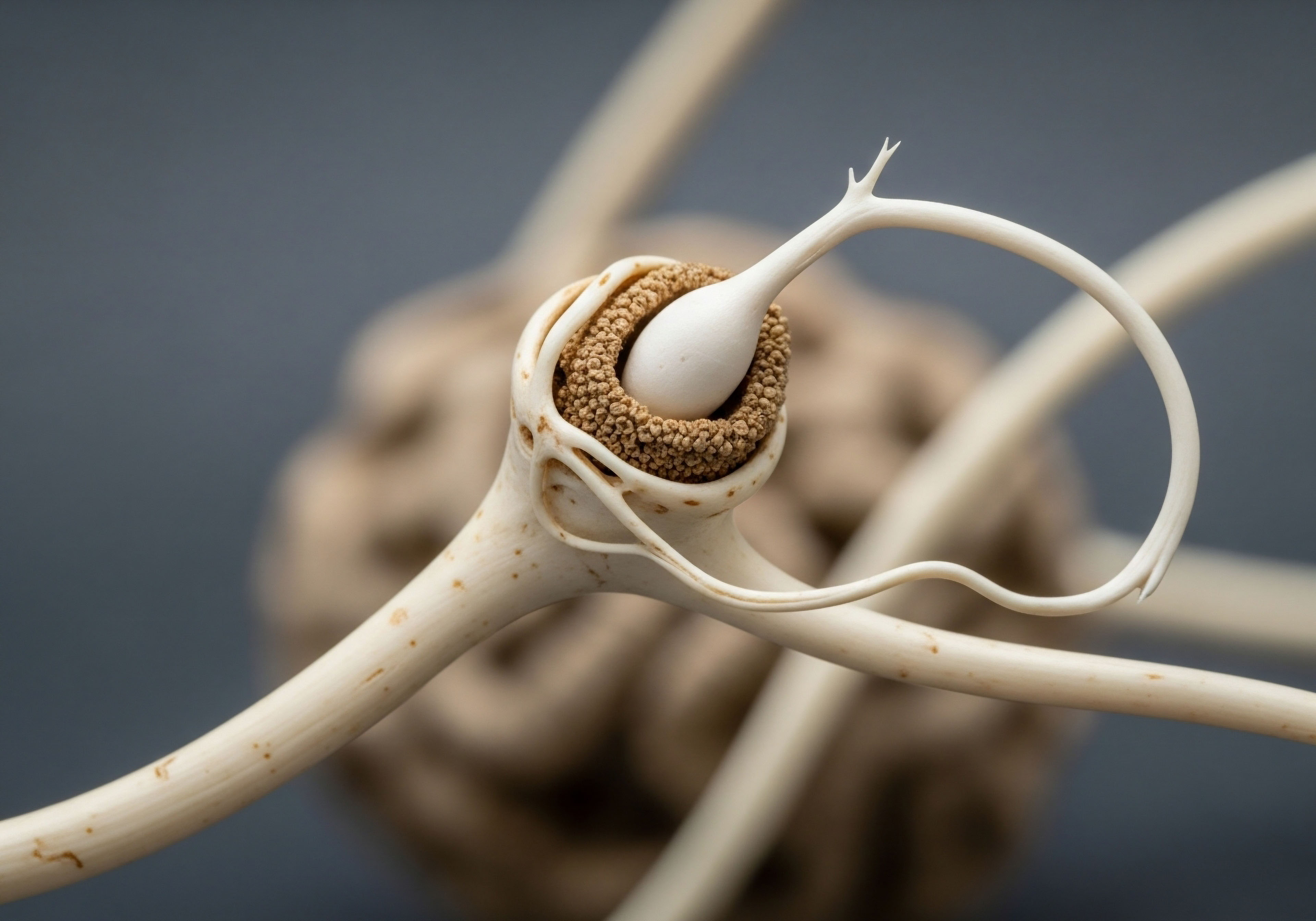

Fundamentals
The experience of desire is a deeply personal and physiological event that originates within the intricate pathways of the central nervous system. Your brain, in this context, functions as the primary organ of desire, orchestrating a complex symphony of biochemical signals that far precedes any physical act.
This internal communication network relies on a specialized class of molecules known as peptides. These are short chains of amino acids that act as precise messengers, traveling between neurons to deliver specific instructions. Their function is to translate the body’s internal state ∞ its hormonal status, energy levels, and sensory inputs ∞ into the cognitive and emotional reality of wanting.
One of the most fundamental systems these peptides interact with is the Hypothalamic-Pituitary-Gonadal (HPG) axis. This is the primary biological conversation between your brain and your reproductive organs. The hypothalamus, a small but powerful region at the base of the brain, acts as the control center.
It releases Gonadotropin-Releasing Hormone (GnRH), a master peptide that initiates a cascade of hormonal signals. This cascade is the foundation upon which desire is built, and its rhythm and intensity are constantly being adjusted by other neuropeptides that provide real-time feedback about your body’s overall condition.
Peptides act as specific chemical messengers within the brain, directly influencing the neural circuits that create the feeling of desire.

The Central Role of Melanocortins
To understand how a peptide can directly influence desire, we can look to the melanocortin system. This network is a prime example of a dedicated pathway within the central nervous system that impacts sexual function. When activated by specific peptides, melanocortin receptors in the brain, particularly within the hypothalamus, initiate a series of downstream signals that enhance arousal.
One of the key peptides in this family is the alpha-melanocyte-stimulating hormone (α-MSH). Studies show that α-MSH and its synthetic analogues can facilitate sexual behavior by acting on these central pathways. This mechanism is entirely separate from the direct action of sex hormones like testosterone, illustrating that desire is a composite of multiple, overlapping biological inputs.
The clinical peptide PT-141, or Bremelanotide, was developed specifically to leverage this pathway. It is a synthetic peptide designed to selectively activate the melanocortin receptors involved in sexual arousal. Its action demonstrates a core principle of neuroendocrinology ∞ targeting a specific receptor in a specific brain region can produce a predictable and potent effect on a complex behavior. This illustrates how feelings that seem spontaneous are, at a molecular level, the result of highly organized and targeted biochemical events.


Intermediate
As we move beyond the foundational concepts, we can appreciate that the central nervous system does not possess a single “desire switch.” Instead, it maintains a dynamic equilibrium between signals that promote arousal and those that inhibit it.
Multiple families of peptides are continuously active, creating a state of readiness or suppression based on a constant flow of internal and external information. The brain integrates these competing signals within key processing hubs, primarily located in the hypothalamus, to determine the overall state of sexual motivation.
This balance is a critical aspect of physiological regulation. For instance, the same brain that uses melanocortins to promote arousal also uses endogenous opioid peptides (the body’s natural pain-relief and reward molecules) to suppress it. Research across multiple species, including humans, confirms that opioid peptides exert a powerful inhibitory effect on sexual performance and motivation. This push-and-pull system ensures that desire is appropriately calibrated to the body’s overall state of health, stress, and safety.

Which Peptides Directly Influence Sexual Arousal?
The modulation of desire is managed by a diverse cast of neuropeptides, each with a distinct role. Some are broadly facilitatory, while others are specifically inhibitory. Their collective influence determines whether the central nervous system pathways for desire are active or quiescent.
- Facilitatory Peptides ∞ These molecules enhance the activity of neural circuits that govern arousal and motivation. Oxytocin, often associated with bonding and social connection, also plays a direct role in facilitating sexual behavior. Similarly, Vasoactive Intestinal Peptide (VIP) and Substance P contribute to pro-sexual signaling within the brain.
- Inhibitory Peptides ∞ These molecules act to dampen sexual desire. Corticotropin-Releasing Factor (CRF), the primary peptide of the stress response, is strongly inhibitory, providing a clear biochemical link between high stress and low libido. Neuropeptide Y (NPY) and Cholecystokinin (CCK), which are also involved in appetite regulation, tend to suppress sexual pathways.
- Context-Dependent Peptides ∞ Some peptides, like Gonadotropin-Releasing Hormone (GnRH), have effects that can vary based on dosage, location of action, and the underlying hormonal environment. While it is the foundational signal for the reproductive axis, its direct behavioral effects are complex and can be facilitatory, inhibitory, or neutral.

Key Peptide Pathways and Their Mechanisms
The following table outlines the primary actions of several key peptides on central nervous system pathways related to desire. Understanding these distinct roles clarifies how different physiological states, such as stress or satiety, can directly impact sexual motivation through specific molecular messengers.
| Peptide Family | Primary CNS Action on Desire | Key Brain Regions of Action | Associated Physiological State |
|---|---|---|---|
| Melanocortins (e.g. α-MSH) | Facilitatory | Hypothalamus (Medial Preoptic Area, Paraventricular Nucleus) | Arousal, Sexual Readiness |
| Endogenous Opioids | Inhibitory | Hypothalamus, Limbic System | Analgesia, High Reward/Satiation |
| Oxytocin | Facilitatory | Hypothalamus, Ventral Tegmental Area | Social Bonding, Orgasm |
| Corticotropin-Releasing Factor (CRF) | Inhibitory | Hypothalamus, Amygdala | Stress Response |
| Neuropeptide Y (NPY) | Inhibitory | Hypothalamus (Arcuate Nucleus) | Energy Conservation, Hunger |


Academic
A sophisticated understanding of desire requires an examination of the precise neuro-circuitry that integrates hormonal feedback with peptide signaling. The regulation of Gonadotropin-Releasing Hormone (GnRH) secretion from the hypothalamus provides a powerful model for this process. GnRH neurons represent the final common pathway for the central control of reproduction.
The pulsatile release of GnRH is what drives the entire HPG axis, and this pulse is governed by a specialized group of interconnected neurons known as the KNDy neurons, located in the arcuate nucleus of the hypothalamus.
The precise, rhythmic firing of GnRH neurons is orchestrated by an intricate interplay of stimulatory and inhibitory peptides within a hypothalamic microcircuit.
KNDy neurons co-express three critical peptides ∞ Kisspeptin (Kiss1), Neurokinin B (NKB), and Dynorphin (Dyn). This co-expression allows for an elegant system of autoregulation that fine-tunes GnRH output with remarkable precision. The interaction between these three peptides is the engine that drives GnRH pulsatility, effectively controlling the tempo of the entire reproductive hormonal system and, by extension, the biological substrate of desire.

How Does the KNDy Neuronal System Operate?
The operation of the KNDy system is a showcase of neural integration. NKB acts as the initiator of the pulse. When released, it binds to its receptors (NK3R) on neighboring KNDy neurons, leading to a synchronized depolarization of the entire KNDy neuronal population. This synchronized firing causes a massive co-release of all three peptides.
Kisspeptin is the primary stimulatory signal for the GnRH neurons. It travels a short distance to the GnRH nerve terminals and binds to its receptor, GPR54, triggering a surge of GnRH into the pituitary portal system.
Dynorphin, the third peptide released in this surge, provides the crucial negative feedback. It acts on kappa opioid receptors (KOR) present on the KNDy neurons themselves. The binding of Dynorphin hyperpolarizes the neurons, effectively shutting down the synchronized firing and terminating the pulse.
This termination allows the system to reset, creating a distinct period of silence before NKB can once again initiate the next pulse. This intricate feedback loop is the source of the pulsatile pattern of GnRH release that is essential for normal reproductive function.

Integration of Hormonal and Peptide Signals
The KNDy system is not isolated. It is a primary target for feedback from gonadal steroids like testosterone and estrogen, which modulate the expression of the KNDy peptides. This is how the brain senses the body’s hormonal state and adjusts its own output accordingly.
Furthermore, other neuropeptides involved in metabolism and stress, such as Neuropeptide Y and peptides from the stress axis, can also synapse onto KNDy neurons, providing a mechanism by which energy status and psychological state can directly influence the master regulator of reproductive function.
For example, research in animal models shows how peptides like obestatin can modulate these gonadotrophic pathways, indicating an even broader network of inputs that influence this core system. This layered control architecture demonstrates that desire is the output of a highly sophisticated biological calculation, constantly being updated by a multitude of peptide signals.
| Component | Peptide | Receptor | Function within the GnRH Pulse |
|---|---|---|---|
| Pulse Initiator | Neurokinin B (NKB) | NK3R | Synchronizes KNDy neurons to start the pulse. |
| Pulse Amplifier | Kisspeptin (Kiss1) | GPR54 | Stimulates GnRH release from GnRH neurons. |
| Pulse Terminator | Dynorphin (Dyn) | KOR | Inhibits KNDy neurons to stop the pulse and create a refractory period. |

References
- Argiolas, A. and G. L. Gessa. “Neuropeptides and sexual behaviour.” Behavioural Brain Research, vol. 41, no. 1, 1991, pp. 83-100.
- Zhang, S. X. et al. “Sex peptide regulates female receptivity through serotoninergic neurons in Drosophila.” PLoS Genetics, vol. 19, no. 2, 2023, e1010613.
- Rezával, C. et al. “Sex-peptide targets distinct higher order processing neurons in the brain to induce the female post-mating response.” eLife, vol. 13, 2024, e93465.
- Jia, M. F. et al. “A hormone-to-neuropeptide pathway inhibits sexual receptivity in immature Drosophila females.” Proceedings of the National Academy of Sciences, vol. 118, no. 8, 2021, e2020087118.
- Gkourtsogianni, S. et al. “The Mystery Actor in the Neuroendocrine Theater ∞ Who Really Knows Obestatin? Central Focus on Hypothalamic ∞ Pituitary Axes.” International Journal of Molecular Sciences, vol. 25, no. 11, 2024, p. 5988.

Reflection
Understanding the molecular ballet of peptides within your brain is a profound step toward reclaiming agency over your own physiology. The science reveals a system of immense complexity and elegance, where the subjective feeling of desire is tied to concrete, measurable biological events.
This knowledge transforms the conversation from one of confusion or frustration to one of informed curiosity. It allows you to see your body’s signals not as arbitrary, but as data. The path forward involves listening to that data and learning how to interpret the language your body is speaking. This journey of biological self-awareness is the true foundation of personalized wellness.

Glossary

central nervous system

gonadotropin-releasing hormone

nervous system

pt-141

opioid peptides

central nervous system pathways

neuropeptide

gnrh neurons

kndy neurons

neurokinin b

kisspeptin




